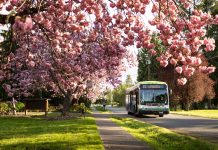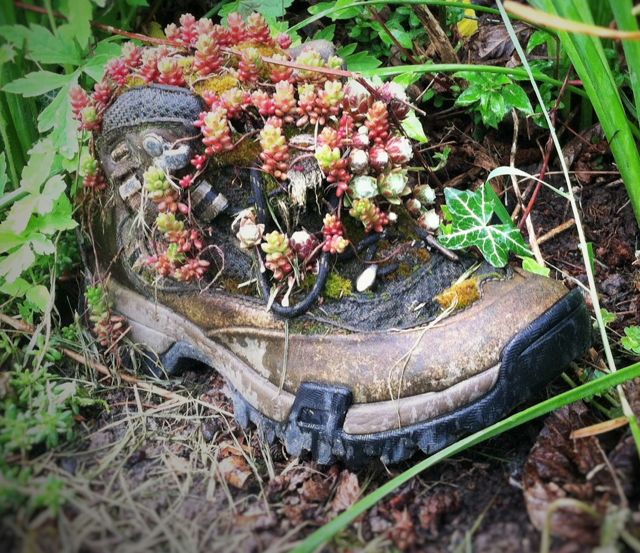By Tali Haller
 Driving through the Olympia area as summer approaches, green is the stand-out color. Along roads lie an assortment of thriving greenery – evergreens shadowing sidewalks, bushes hovering, and wildflowers beautifying the landscape. In the neighborhoods, gardens are vibrant with color and ripe with vegetation – tulips, daisies, trellises draped with budding honeysuckle, and brilliantly-colored flowering trees. Yet the same gardens and greenery which bring such aesthetic enjoyment, are also serving another green purpose: they are each playing their own small part in contributing to the global sustainability movement. “It’s all about keeping the earth healthy,” commented Anne, a local gardener.
Driving through the Olympia area as summer approaches, green is the stand-out color. Along roads lie an assortment of thriving greenery – evergreens shadowing sidewalks, bushes hovering, and wildflowers beautifying the landscape. In the neighborhoods, gardens are vibrant with color and ripe with vegetation – tulips, daisies, trellises draped with budding honeysuckle, and brilliantly-colored flowering trees. Yet the same gardens and greenery which bring such aesthetic enjoyment, are also serving another green purpose: they are each playing their own small part in contributing to the global sustainability movement. “It’s all about keeping the earth healthy,” commented Anne, a local gardener.
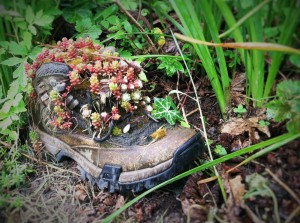
Talking with many gardeners around Olympia has resulted in a variety of conclusions. First, there is no “one” way to garden. Second, it’s all about the simple things. Third, using sustainable methods can reduce the cost required to cultivate a garden. Finally, gardening does seem to require time (although, as many gardeners point out, it can be considered part of your daily exercise and outdoor activity).
Remarkably, some gardeners are creating sustainability in their gardens by upcycling old or discarded materials. Gardener Paula Rutan, a Lake St. Clair resident, used her daughter’s old shoes as planting pots, cleverly upcycling worn-out footwear (see 35 Ideas to Use Old Shoes As Planters). Not only do the “pots” hold sentimental value, but they also give the flower a unique avenue to grow upon. As seen in the picture, the pink flower buds have the freedom to travel down the laces.
Another prime example of the “upcycle” idea can be seen in Eastside Olympia gardener Nate’s home project. Although not exactly related to the garden, he’s currently using wood from pallets, old crates, and other found materials to build a studio for his wife, which happens to be situated in the garden. For people who enjoy the rustic, practical look, this can be a great way to save money.
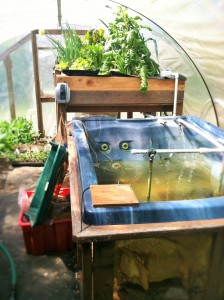
Aside from his studio project, Nate is also very involved in gardening and growing his own food. “I started gardening mainly because I had major issues with our food system. Plus, I love to be outside,” he explained.
In order to gain more control over his food source, Nate began to experiment with aquaponics, the combination of fish farming and gardening. In general, aquaponics combines the raising of aquatic animals like fish, prawns, or snails in tanks with the nearby cultivation of plants in water (hydroponics). In this symbiotic relationship, water from the aquaculture, rich in excretion, is piped to the hydroponic system. Once there, the plants absorb the water, utilizing the nutrients and cleaning the water, which is then recirculated back to the aquaculture system.
Nate’s home-made system works similarly. A relatively inexpensive piping system, situated in a hot tub, is activated when the water level reaches a certain height, triggering the pump to begin transporting the “dirty water” to plants growing in a bed of lava rocks. Completely soilless, the plants absorb as many nutrients as they can before a specific “low” water level triggers the deactivation of the pump.
“At some point, I hope to have some Tilapia to eat,” remarked Nate, who is continually updating the system. Just recently, he invested in an automatic feeder, increasing the self-sufficiency of what he terms his “mini-ecosystem.” The whole set-up costs easily under $500, with the hot tub simply a “found item” and lumber for the plant bed salvaged on Craiglist.com. “The main costs come from the piping system,” said Nate, who mentions this article about how to make your own aquaponic system.
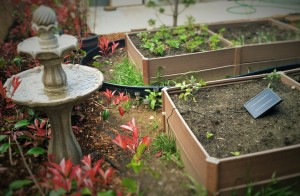
Aside from initial costs, there are a whole sweep of benefits. The home-grown vegetables and fish, for one, but also environmental benefits. “This type of system is much less water intensive for growing plants, especially because you can have a higher density grown together since they aren’t fighting for nutrients,” Nate commented. While aquaponics may be a relatively new term, an article in Business Insider predicts that the “Aquaponic Fish Farmer” will be a commonplace job by 2030.
Also remarkable, some Olympia gardeners are using solar power. To power her garden fountain, Tammy Morris uses a rectangular solar panel. Although she bought hers online in a package with the fountain (prices average between $50 to $300), a simple Do-It-Yourself solar panel can also be created with relative ease.
Morris can turn the panel on and off by remote. “I chose to go solar because I didn’t want to waste electricity but I love the beauty of a garden fountain. I love hearing the gurgle of water,” she said. After storing up ambient sunlight, her fountain can run for about 3 hours. “I also use rocks in my garden to cut down on the cost of watering grass, prevent weeds, and create a lower-maintenance garden,” Morris said.
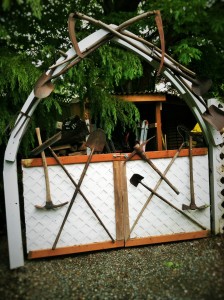
Gardener Cathy Johnson owns an Olympia based landscape design, container planter, and garden art business called Dandelion Gardens. She obtains her stock from all over the Pacific Northwest, each year attending a myriad of art festivals, including one down in Portland, Oregon called “Crackedpots.” The artists involved must make their crafts out of recycled materials, aiming to encourage the community to look creatively at trash. One of the regular sellers makes beautiful, vibrant “dresses” which are recycled from melted window screen material. She uses the recycled art to spruce up her garden, adding color to the greenery typical of an English-themed garden.
Like Nate, Cathy has multiple facets of sustainability and upcycling occurring on her property. “My current project is an arbor made out of old shovels,” explained Johnson, who got the idea in Maine about five years ago. Her hope is to grow plants up and around the arbor, creating a trellis.
Other gardeners focus on creating habitat for birds and other animals. “When I first moved onto my property, there was nothing on the hillside, so we planted a bunch of flowers and vegetation that would hold the soil and attract animals,” said local gardener Paula Rutan. She also mixes berries and some vegetables into her garden, both for herself and to feed the birds nesting in her garden. “I try to keep my fertilizers and pesticides as natural as possible,” she mentioned. This being said, she uses leftover coffee grinds, which contain high levels of nitrogen, to provide organic soil nutrients to her blueberry plants.
A final conclusion to be drawn is that gardening is always a work in progress. Throughout all of my visits –time and time again- I heard repeatedly, “It’s not done yet.” This statement was often accompanied by an expression containing both pride and mild embarrassment, as though the gardener was proud of their work but upset by the fact that it was being judged before it was “finished.” But really, isn’t part of a gardens beauty its evolution –its adherence to a cycle of life and death, as spring awakens vibrant colors and winter brings hibernation?
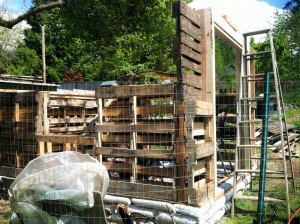
Further Reading:
- Keyhole gardens: a sustainable, traditional way to grow food
- The $200 Hydroponic Greenhouse You Control With a Smartphone
- Sustainable Grove Towers will “Clean Mumbai’s Air”









